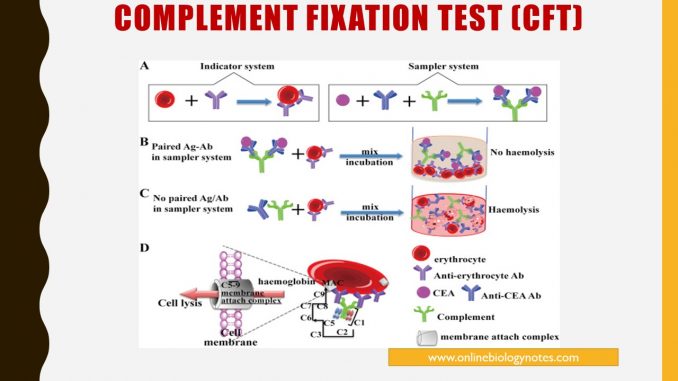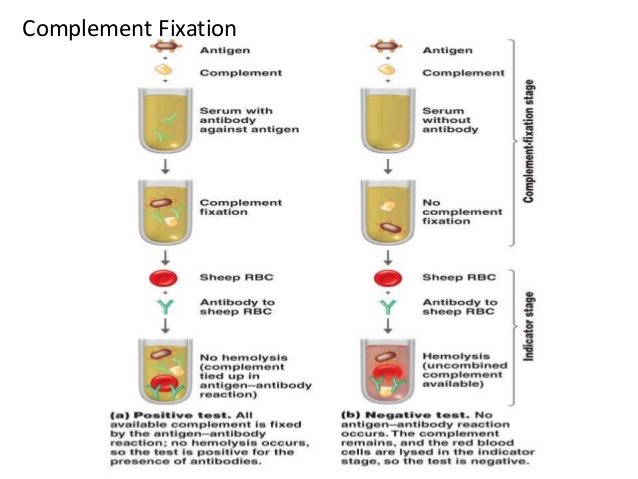
Complement fixation test: principle, procedure, result interpretation, applications and limitations
Principle of complement fixation test:
- Complement fixation test is used to detect and quantify antibody in serum that does not form visible precipitate or agglutinate when reacted with antigen until complement is used. Complement is a heat labile globular protein present in normal serum. Whole complement system is composed of 9 protein components ie. C1, C2,C3….C9.
- Complement can only bind Ag-Ab complexes. When complement takes part in antigen-antibody reactions it is bound or fixed to the Ag-Ab complexes. When these complexes are on bacteria, RBCs or other cells, the complement brings about the lysis of these cells. Complement cannot bind free antibody.
- Antigen-antibody complex fixes the complement. But the fixation of complement with Ag-Ab complex do not have any visible effect like agglutination and precipitation. So it is necessary to use indicators system.
- The indicator system consists of sheep RBC coated with anti-sheep RBC antibody (Amboreceptor).
- The test serum is inactivated by heating at 56°C for 30 minutes to destroy the complement activity of test serum and to remove anti-complementary effect of some non-specific inhibitors in the serum.

Standardization of complement:
- Complement activity is determined by titration of freshly drawn Guinepig serum. One unit or minimum hemolytic dose (MHD) of complement is defined as the smallest amount (highest dilution) of serum that will causes complement lysis of arbitrarily selected one unit volume of washed sheep red blood cells in the presence of excess antibody (amboreceptor) in a fixed time (30-60 minutes) at a fixed temperature (37°C).
Titration of Amboreceptor:
- The amboreceptor is titrated for determination of hemolysin activity. One MHD of hemolysin (antibody) is determined as the smallest amount (highest dilution) of inactivated amboreceptor that will cause complete lysis of one unit volume of washed RBCs in the presence of excess complement within a fixed time (30-60 minute) at a fixed temperature (37°C). For titration normal saline added with calcium and magnesium is used as diluent.
Requirements for CFT:
- Test system:
- Antigen: cardiolipin/ Viral Ag/ washed Sheep RBCs
- Hemolysin: inactivated patient’s serum
- Complement ( Guineapig serum)
- Indicator system: Sheep RBCs coated 4MHD hemolysin
- Water bath for incubation
- Microtiter plate
- Centrifuse adaptor for microtiter plates
- Barbital-buffered diluent ( normal saline added with calcium and magnesium)
- Color standards for comparision
Procedure of complement fixation test:
- A known antigen (cardiolipin/Viral Ag/sheep RBC) is mixed with inactivated patient’s serum
- Add a measured amount of complement ( Guineapig serum) in the test system
- The test system is incubated at 37°C for about 1 hour.
- After 1 hour an indicator system (sensitized RBC) is added to the test system and again incubated at 37°C for 30 minutes
- If Ag and Ab matches, they form Ag-Ab complex and utilizes complement.
- Observe the result

Observation:
- If hemolysis is observed: it indicates the absence of specific antibody in patient serum, so that complement has not been used which lysed the sensitized RBC giving hemolysis.
- If no hemolysis is observed: it indicates that the patient serum contains antibody which reacts with Ag to form Ag-Ab complex and then fix complement .so that no complement is available to hemolyse sensitized RBC.
Result interpretation:
- Positive CFT: if no hemolysis is observed, it indicates positive complement fixation test. Antigen- antibody reaction and complement fixation occurs, so NO free complement is available to lyse the RBC.
- Negative CFT: if hemolysis of RBC observed, it indicates negative complement test. NO complement fixation occurs, so the complement remain free and it hemolyse the RBC.
Applications of CFT:
- CFT is used to detect and quantify antibody that does not agglutinate or precipitate with its antigen.
- CFT can detect antibody at level less than 1 microgram per milliliter.
- CFT is also used to detect antigen
- CFT is Economical
- CFT can be used to screen large numbers of viral or bacterial infection.
Limitations of CFT:
- Less sensitive; it can nnot be used for immunity screening
- Non- specific
- Time consuming
- Labor intense
